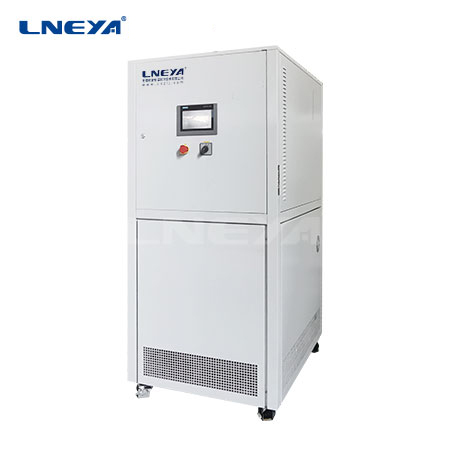Closed Recirculating Cooling Water System
Contattateci oggi stesso per la soluzione di controllo della temperatura perfetta
A closed recirculating cooling water system uses cooling water to pass through a heat exchanger to cool process media or materials. Through heat exchange, the temperature of the cooling water rises and becomes hot water, and then other cooling media (such as air) are used to cool the hot water. The cooled water is recycled due to the temperature drop.
The secondary cooler uses other cooling media (such as air) to cool the hot water after the temperature has been raised. The secondary cooler is also a heat exchanger. Its outside is often equipped with wing-shaped fins or other shaped heat sinks made of materials with high thermal conductivity (such as aluminum, copper) to increase the heat dissipation area and improve cooling efficiency. . Some designs place the secondary cooler equipped with wing-shaped fins in a mechanical ventilation cooling tower, which can greatly improve the cooling efficiency.
Because the cooling water of the closed recirculating cooling water system is closed and generally has no material exchange with the outside world, the concentration of various minerals and ions in the closed recirculating cooling water system hardly changes.

The characteristic of the closed recirculating cooling water system is that it does not come into contact with the air, but dissolved oxygen still exists in the actual system. This is due to leaks in valves, pipe interfaces, water pump packing, etc., which bring in a small amount of oxygen. In addition, small amounts of supplemental water are also a source of dissolved oxygen. Therefore, there is chemical corrosion of oxygen in the closed recirculating cooling water system. Since the system is usually composed of different metal materials, which may be copper or copper-nickel alloy heat exchange tubes, stainless steel, galvanized steel pipes or mild steel pipes, the closed recirculating cooling water system also has problems caused by different metal materials. electrochemical corrosion. The closed recirculating cooling water system commonly uses softened water as supplementary water, or natural water treated with simple methods as supplementary water.
Closed recirculating cooling water systems are generally only used in industrial production systems with small heat transfer or special requirements, such as air conditioners, generators, internal combustion engines, transformer oil coolers, auxiliary coolers of nuclear reactors, etc. Closed recirculating cooling water systems are generally used for single heat exchange equipment.
E-mail: info@lneya.com ID WeChat: +8615251628237 WhatsApp: +86 17851209193
 Refrigeratori di precisione / Piccoli refrigeratori
Refrigeratori di precisione / Piccoli refrigeratori
Il refrigeratore può essere ampiamente utilizzato in vari settori industriali e laboratori e supporta la progettazione personalizzata.
| Intervallo di temperatura | -18°C ~ +30°C | Serie +5°C ~ +35°C |
| Capacità di raffreddamento | 0,35 ~ 0,9 kW | 1,8 ~ 50kW |

Refrigeratori a ricircolo
Il nostro refrigeratore a ricircolo adotta la tecnologia di refrigerazione a bassa temperatura, la temperatura è fino a -120℃ e vari accessori sono personalizzabili.
| Intervallo di temperatura | Serie -25°C ~ +30°C | Serie -45°C ~ +30°C | Serie -60°C ~ -20°C | Serie -80°C ~ -20°C | Serie -120°C ~ -70°C |
| Capacità di raffreddamento | 0,8 ~ 30kW | 0,75 ~ 12kW | 0,4 ~ 6kW | 0,2 ~ 6kW | 0,3 ~ 5kW |

Refrigeratori a bassa temperatura
Siamo specializzati nella produzione di refrigeratori a bassa temperatura con un range di controllo della temperatura fino a -150°C, in grado di soddisfare le esigenze di refrigerazione di diversi settori industriali.
| Intervallo di temperatura | Serie -25°C ~ -5°C | Serie -45°C ~ -10°C | Serie -60°C ~ -10°C | Serie -80°C ~ -30°C | Serie -110°C ~ -50°C | Serie -150°C ~ -110°C |
| Capacità di raffreddamento | 12 ~ 360kW | 6 ~ 180kW | 6 ~ 180kW | 4 ~ 180kW | 2 ~ 120kW | 2,5 ~ 11kW |
Simulazione della temperatura per il test di qualità del veicolo: test di durata della batteria, banco di prova dell'iniettore/motore del carburante, test dell'airbag, banco di prova dei componenti, ecc.

Adatto per il controllo preciso della temperatura dei componenti elettronici. Nella produzione di componenti elettronici a semiconduttore per ambienti difficili, le fasi di assemblaggio dell'imballaggio IC e di test di progettazione e produzione includono test termici elettronici e altre simulazioni di test ambientali.

Raffreddamento a liquido per i sistemi di accumulo di energia a batteria
| Tipi | Per la stazione di conversione | Per la batteria di accumulo dell'energia | Per la stazione di ricarica |
| Capacità di raffreddamento | 45kW | 5 ~ 8,5kW | 4kW |

Serie ZLFQ
Unità di distribuzione del refrigerante
L'apparecchiatura di raffreddamento a liquido è adatta per il test dei semiconduttori, per il test della temperatura costante delle apparecchiature elettroniche, per il raffreddamento dell'infrastruttura di supporto dei server e per altri luoghi di controllo della temperatura dei fluidi.
| Intervallo di temperatura | +5°C ~ +35°C | +5°C ~ +35°C |
| Capacità di raffreddamento | 15 ~ 150kW | 200 ~ 500kW |

Serie di mandrini termici MD
Viene utilizzato per testare dispositivi RF e dispositivi di potenza ad alta densità (IGBT e MOSFET) e può essere utilizzato anche per il raffreddamento rapido di pannelli piatti da laboratorio (plasma, prodotti biologici, batterie), ecc.
| Intervallo di temperatura | -75°C ~ +225°C |
| Precisione della temperatura | ±0.1℃ |

Refrigeratori a vite (Disegni personalizzati)
Refrigeratori a vite a bassa temperatura e a temperatura ambiente
| Intervallo di temperatura | +5°C ~ +30°C | +5°C ~ +30°C | +5°C ~ +30°C | +5°C ~ +30°C | -25°C ~ +5°C | -25°C ~ +5°C |
| Capacità di raffreddamento | 107 ~ 1027kW (compressore singolo) | 299 ~ 2134kW (doppio compressore) | 98 ~ 934kW (compressore singolo) | 272 ~ 1940kW (doppio compressore) | 48 ~ 467kW (compressore singolo) | 51 ~ 497kW (compressore singolo) |
 LNEYA
LNEYA
 简体中文
简体中文



















































































